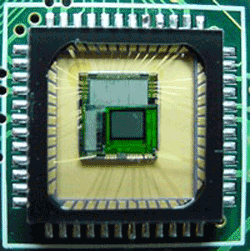Both image sensors have their advantages, but which is right for you?
When you take a picture, light passes through the lens of the camera and falls on an image sensor. The sensor is made up of thousands, or millions, of tiny picture elements, typically referred to as “pixels,” which register the amount of light that falls on them. The pixels convert the received amount of light into a corresponding number of electrons. These electrons form voltage signals, which get transformed into numeric code via an A/D-converter, and are processed by electronic circuits within the camera to form a digital image.
In today’s cameras, there are two main forms of image sensor technology – the charge-coupled device (CCD) and the complementary metal-oxide semiconductor (CMOS). While both sensors perform the same task, they’re actually quite different when it comes to how they function. Understanding each one’s unique characteristics will help you choose a CCD- or CMOS-based device that’s most in line with your personal or professional needs.
The CCD image sensor:

With a CCD, light projected onto the pixel is collected as a charge and transferred to its neighbor. The last pixel in the array dumps the coupled charges (hence the name) through an output node, or a few output nodes, into an amplifier that alters the charge into a voltage. This process is repeated until there’s a sequence of voltage levels, which then get buffered and sent out as an analog signal. The signal is amplified and converted to numeric code using an A/D converter, and processed by the device’s electronic circuitry to form a digital image.
What’s great about this procedure is that each pixel is devoted to capturing as much light as possible. In fact, some CCDs have a 70% quantum efficiency rate! This means that the output uniformity of a CCD image sensor is very high which, for the user, translates to terrific image quality.
The biggest disadvantage to the CCD is that it requires more exterior components than a CMOS. This makes them expensive to produce. It also means that they require additional power. In some instances, a CCD image sensor can consume up to 100 times more power than a comparable CMOS sensor. More power means a greater possibility of heat issues, which can have a negative impact on image quality.
The CMOS image sensor:

The most striking difference about the CMOS is that each pixel has its own charge-to-voltage converter. Once the convert is complete, the charge is moved using traditional wiring. This particular design scheme is beneficial because it means that all of the logic necessary for producing an image is already right there within the chip, as opposed to being externally located like the CCD. It allows for a faster readout, and makes the CMOS ideal for use in complex technologies like multi-megapixel cameras. It also provides better integration and has made unique capabilities like “windowing” and multiview streaming available to users. The CMOS’s reduced space usage permits smaller devices and because factories use the CMOS manufacturing process, the most common and highest yielding chip-making process in the world, the fabrication cost for the CMOS is significantly less than the more specialized CCD process. These savings have since led to a new generation of more affordable digital cameras.
One disadvantage to the CMOS actually comes as direct result of the extreme intricacy of the chip’s design. Due to the fact that there are so many additional elements within the CMOS chip, there’s actually a reduction in area available for the sensor to capture light; that is, photons that should be hitting the pixels instead hit the chip’s extra components. Furthermore, the fact that all of the circuitry is together on one chip makes the CMOS sensor subject to an increase risk of noise pollutants like stripes and other patterns.Recapfajb_cmosvsccd03_sept2011
Where they stand in today’s marketplace:
In the past, there were some major differences between CCD and CMOS image sensors, including price, performance, and reliability. The advancements that both technologies have made, especially within the last five years, have put them more on an equal playing field. Specifically, CCD makers lowered their power and size requirements to make CCD devices more user friendly, while CMOS manufacturers primarily focused on their sensor’s ability to produce better-quality images. This has led to the integration of both sensors in areas where they weren’t used in the past. For example, CCD sensors are now being used in some camera phones, while CMOS sensors can be found in high-performance professional and industrial cameras.
So which one should you choose?
First off, don’t believe everything you hear about these technologies. There are enthusiasts on both sides who are more interested in getting their selling point across rather than actually providing helpful information. The fact of the matter is that neither the CCD nor the CMOS is superior to the other, whether it’s in regards to price, performance, or reliability.
With that being said, your best bet is to make a decision based upon your shooting style and how you plan to use the device. If you need a camera that consistently turns out high-quality images, you can’t go wrong with one that has a CCD in it. If, however, you prefer a power-efficient device with expanded capabilities, then you’ll probably find the CMOS to be a better fit instead. Either way though, the image sensor in the camera you choose is likely to meet your expectations. ■
Advertisement
Learn more about Electronic Products Magazine





